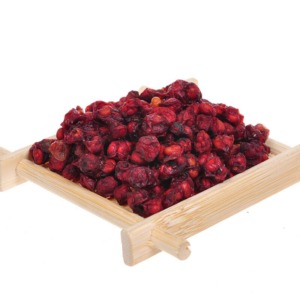Schisandra chinensis contains many bioactive compounds, including lignans, triterpenes, phenolic acids, flavonoids, essential oils, and polysaccharides. Lignans are mainly responsible for the pro-health properties. These compounds are predominant in schisandra chinensis fruits, but can also be found in the leaves, shoots, and seeds.
The most widely represented groups of schisandra chinensis lignans are dibenzocyclooctadiene lignans, which are often referred to as “schisandra lignans”. Within dibenzocycloactadiene lignans, which occur in the largest amounts in the fruits of Schisandra chinensis, are schisandrin (syn. schisandrol A, wuweizisu A), schisandrin B (syn. gomisin N, wuwezisu B, γ-schisandrin), schisantherin A (syn. gomisin C, schisandrer A), schisantherin B (syn. gomisin B, schisandrer B), schisanhenol (syn. gomisin K3), deoxyschisandrin (syn. schisandrin A), and gomisin A (syn. schisandrol B).
The content of individual lignans in schisandra chinensis fruits depends on the location of the crop, the degree of fruit maturity, and harvest season. Ten fruit samples from different provinces of China were tested. In six of them, schisandrin was predominant (2.199–5.332 mg/g), while, in the other four, schisantherin A (2.263–6.36 mg/g) dominated. The results showed the highest content of schisandrin (3.51–11.08 mg/g). This compound constituted 36%–46% of the Schisandra lignans in fruits originating. In eight out of ten fruit samples tested, the relationship in the concentration of SCE lignans was schisandrin > gomisin A > schisandrin B.
Another important group of biologically active compounds extracted from schisandra chinensis is the triterpenoids. They constitute a broad and structurally diverse group of chemical compounds. schisandra chinensis contains lanostane and cycloartane-type triterpenoids and nortiterpenoids, which are often called as “Schisandra nortriterpenoids” or schinortriterpenoids. An example of a compound belonging to the lanostane-type triterpenoids is kadsuric acid. Examples of cycloartane-type triterpenoids are schisanlactone D and wuweizilactone acid. Schinorterpenoids are extracted from different parts of the plant—fruits (schindilactone A, wuweizidilactone I), leaves (schindilactones IK, wuweizidilactones JP, schisanartanin N), rattan stems (schindilactone LM, wuweizidilactone S), and roots (schinchinelactone D).
Flavonoids and phenolic acids, which are polyphenols, display antioxidant properties. They are secondary plant metabolites, which occur in every part of the plant (i.e., fruits, flowers, seeds, leaves, roots, or even lignified parts). Among phenolic acids, it was found chlorogenic acid in the fruits of schisandra chinensis, while in the leaves two other derivatives of hydroxycinnamic acid (p-cumaric and ferulic) were found. Chlorogenic acid and five hydroxybenzoic acid derivatives are found in the leaves and fruits, including gallic, p-hydroxybenzoic, protocatechuic, syringic, and vanilic acids.
Flavonoids present in schisandra chinensis fruits are isoquercitin, quercetin, and its derivatives—quercetin 3-galactoside (hyperoside) and quercetin 3-rutinoside (rutin). schisandra chinensis leaves also contain quercetin 3-ramnoside (quercitrin) myricetin and kaempferol. Fruits of schisandra chinensis also comprise the cyanidin derivatives: Cyanidin-xylosylrutinoside, cyanidin-glucosylrutinoside, cyanidin-xylosylglucoside, and cyanidin-rutinoside, belonging to the anthocyanins.
Schisandra chinensis fruits also contain essential oils, which is called schisandra essential oil(also called schisandra oil). The content of individual groups of compounds can be put in the following order: Sesquiterpene hydrocarbons > oxygenated sesquiterpenes > oxygenated monoterpenes > monoterpene hydrocarbons. The main aromatic compounds are ylangene (11.93%–37.71% of the volatile fraction), α-himachalene (18.03%–20.7%), and β-himachalene (6.29%–10.46%).
Finally, polysaccharides extracted from schisandra chinensis fruits have been intensively studied. schisandra chinensis is the source of homogeneous polysaccharides composed mainly of glucose, galactose, mannose, and rhamnose in various molar proportions. Polysaccharides also occur in combination with uronic acid and proteins.
Schisandra chinensis fruits contain substantial amounts of minerals, including Fe, Mn, Cu, K, and Mg.


Leave A Comment